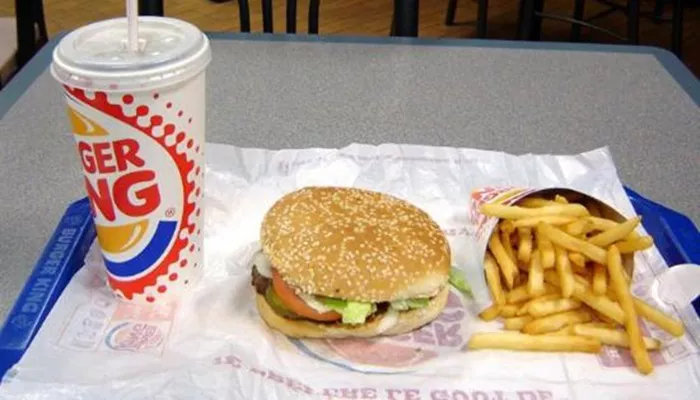Burger King, one of the most recognizable fast-food chains in the world, has a rich history that dates back to the early 1950s. This article delves into the timeline of Burger King’s inception, focusing specifically on when it began selling hamburgers and how it evolved into a global phenomenon.
The Birth of Insta-Burger King
The story of Burger King begins in 1953 when Keith J. Cramer and his stepfather, Matthew Burns, opened a restaurant called Insta-Burger King in Jacksonville, Florida. They were inspired by the success of the McDonald brothers’ hamburger stand in California. Cramer and Burns purchased two pieces of equipment known as “Insta-Broilers,” which allowed them to cook hamburgers quickly and efficiently. This cooking method became a cornerstone of their business model, enabling them to serve freshly grilled burgers to customers.
The first Insta-Burger King opened its doors on July 23, 1954. The menu initially featured a variety of items, but hamburgers quickly became the star attraction. The innovative cooking method used in their Insta-Broilers allowed for a unique flavor profile that set them apart from other fast-food establishments at the time.
SEE ALSO: Why Did Burger King Discontinue The Ch King
Transition to Burger King
Despite the initial success, Insta-Burger King faced financial difficulties by 1959. To save the struggling chain, Cramer and Burns sold it to two Miami-based franchisees, James McLamore and David R. Edgerton. Upon acquiring the company, McLamore and Edgerton rebranded it as Burger King. This marked a significant turning point in the company’s history.
Under McLamore and Edgerton’s leadership, Burger King began to expand rapidly. They recognized the potential for franchising and started selling territorial licenses to private franchisees across the United States. By 1959, they had already established several locations within Florida and were beginning to branch out into other states.
The Introduction of The Whopper
In 1957, just a few years after rebranding, Burger King introduced its most iconic menu item: the Whopper. Created by James McLamore, the Whopper was designed to compete with larger burgers offered by rival chains. Priced at 37 cents at launch, it was marketed as a hefty burger that could satisfy even the heartiest appetites.
The Whopper’s introduction was not merely about expanding the menu; it was a strategic move that solidified Burger King’s identity as a competitor in the fast-food industry. The burger’s size and quality appealed to customers who were looking for more than just a quick meal; they wanted an experience.
Expansion Beyond Florida
As Burger King’s popularity grew, so did its ambition. By 1961, just two years after launching the Whopper, Burger King had expanded beyond Florida’s borders and opened its first location in Illinois. This expansion was crucial for establishing Burger King’s presence in the national market and set the stage for future growth.
The franchise model employed by McLamore and Edgerton allowed for rapid expansion while maintaining quality control over food offerings. They ensured that all franchisees adhered to strict standards regarding food preparation and service quality.
Innovations in Marketing
Burger King’s marketing strategies also played a significant role in its growth during this period. In 1958, they aired their first television advertisement, which helped introduce their brand and menu items to a wider audience. This move was pivotal in establishing Burger King as a household name.
The company continued to innovate its marketing approach throughout the years. The introduction of memorable slogans such as “Have It Your Way” in the late 1970s emphasized customer choice and personalization—a concept that resonated with consumers.
Challenges And Resilience
Despite its successes, Burger King faced challenges along the way.
The fast-food industry became increasingly competitive with rivals like McDonald’s and Wendy’s entering the market with their own unique offerings. In response to these challenges, Burger King continued to innovate both its menu and marketing strategies.
In 1978, under new management from Pillsbury Company, Burger King introduced breakfast items to compete with McDonald’s breakfast offerings. This move significantly broadened their customer base and increased sales during morning hours.
Conclusion
From its humble beginnings as Insta-Burger King to becoming an international fast-food giant known for its flame-grilled hamburgers, Burger King’s journey is marked by innovation, resilience, and an unwavering commitment to quality. The introduction of hamburgers as a core menu item laid the foundation for what would become one of the most successful fast-food chains globally.
Today, Burger King continues to adapt to changing consumer preferences while staying true to its roots—serving delicious hamburgers that cater to diverse tastes around the world. The legacy of Burger King’s hamburger sales began in earnest with its rebranding in 1959 and has since evolved into a cultural phenomenon that remains relevant decades later.
Through strategic expansions, innovative marketing campaigns, and a focus on customer preferences, Burger King has solidified its place in fast-food history as a leader in serving high-quality hamburgers that satisfy customers’ cravings across generations.
Related topics:
- How Much to Franchise Jollibee in Manila?
- What Is The New Hamburger Called at Arby’s in 2024
- What Brand of Coffee Does Wendy’s Use?


